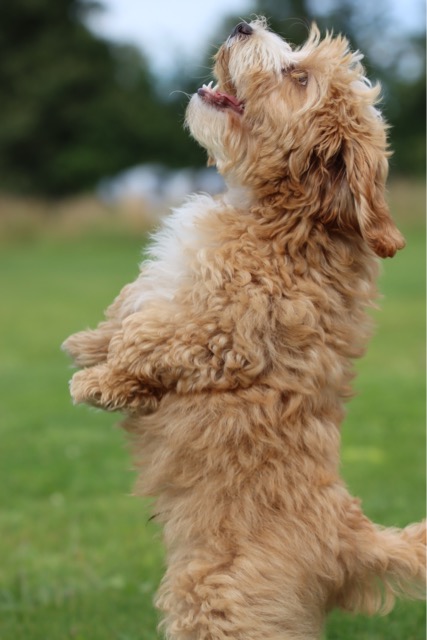Historie

De Australiër Wally Conron is de geestelijke vader van de labradoodle,
Conron, een fokker van de Royal Victorian Guide Dogs Association, kruiste voor het eerst een poedel met een labrador in 1989. Zijn doel was om de een hond te creëren die de vachtstructuur heeft van een poedel en de “will to please” van de labrador retriever. Het was ook Conron die de naam labradoodle bedacht heeft.De inspiratie voor deze kruising kwam van een Hawaïaans koppel die Wally Conron eind jaren ’80 hebben gevraagd om voor hen een hulphond te fokken die bij hen zouden passen. De vrouw van het koppel was namelijk slechtziend en had een blindengeleidehond nodig, maar haar echtgenoot was allergisch voor de meeste honden.
Deze eerste generatie kruisingen bleek erg leuk, maar nog niet stabiel wat betreft geschiktheid als hulphond en allergievriendelijkheid. Men ging verder met ontwikkelen en door het inbrengen van nog enkele andere rassen ontstond de Australian Labradoodle. De rassen die “gebruikt” zijn om tot de ontwikkeling te komen zijn natuurlijk de labrador en de poedel, maar ook de Ierse waterspaniel, de curly coated retriever en de Amerikaanse en Engelse cocker spaniel. Je kan dus niet zomaar een Australian Labradoodle krijgen door alleen een poedel en een labrador met elkaar te kruisen.
Karakter

De Australian Labradoodle is vrolijk, vriendelijk en sociaal ten opzichte van ieder mens en dier. Hij is dol op aandacht, knuffelen, spelen en kinderen, Een Australian Labradoodle heeft wel veel behoefte aan mensen om zich heen en is er niet dol op om alleen gelaten te worden. Met andere woorden: de ideale huishond.
Australian Labradoodles zijn de meest lieve, stabiele en vrolijke honden die je je kunt voorstellen. Ze hebben een uitzonderlijk groot geduld met kinderen. Ze zijn aanhankelijk, loyaal, grappig en ze zijn geschikt voor mensen met een allergische of astmatische aanleg. Omdat ze intelligent, sensitief en welwillend zijn, worden ze ook steeds vaker ingezet als hulp- of therapiehond. Het is moeilijk uit te leggen hoe geweldig deze honden zijn, als je ze nog niet in levende lijve hebt ontmoet
De Australian Labradoodle is zeer geschikt als familiehond, maar kan ook heel goed ingezet worden als therapie- cq hulphond. Ze worden regelmatig gebruikt als therapiehond voor kinderen met autisme, adhd of andere speciale behoeften.
Uiterlijke kenmerken

Lichaamsbouw
De Australian Labradoodle is compact, maar sierlijk gebouwd. De staart heeft met voorkeur de vorm van een sabel, hij heeft hangende oren, en grote ogen met hele lange wimpers. Opvallend zijn natuurlijk zijn mooie, lange krullende haren.
Kleur
De Australian Labradoodle komt in heel veel kleuren voor. Je hebt eenkleurige honden in de kleuren:
abrikoos, caramel, chocolade, crème, rood, wit, zwart
Meerkleuring zijn de parti en phantom.
Schofthoogte
Er zijn Australian Labradoodles in drie verschillende formaten:
Mini: schofthoogte tussen de 35 en 42 cm
Medium: schofthoogte tussen de 43 en 52 cm
Standaard: schofthoogte tussen de 53 en 63 cm
Vacht
De Australian Labradoodle heeft geen ondervacht waardoor ze niet of nauwelijks verharen en zo goed als reukloos zijn.. Er bestaan Australian Labradoodles met een curlyvacht of met een fleecevacht. Een fleecevacht is veel losser van structuur en kan voorkomen met kleinere krullen (curly fleece) of met grove krullen tot bijna golven (wavy fleece).
Lichaamsbeweging

Australian Labradoodles zijn levendige en intelligente metgezellen die gedijen bij zowel fysieke als mentale stimulatie. Een simpele wandeling om het blok is niet genoeg voor deze energieke honden; ze hunkeren naar avontuur en vergezellen hun baasjes graag op lange, verkwikkende wandelingen. Hun enthousiasme stopt niet bij activiteiten op het land: veel Australian Labradoodles hebben een natuurlijke affiniteit met water en genieten van zwemmen, waardoor ze perfecte partners zijn voor stranduitjes of retraites aan het meer.
Door hun behendige geest te betrekken met interactieve spellen of trainingssessies, verrijkt u hun leven verder en zorgt u ervoor dat ze gelukkige en evenwichtige huisdieren blijven.


